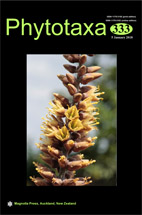Abstract
During a bioprospecting of fungi producing antimicrobial volatile organic compounds, two Verticillium-like isolates from coffee branches were obtained by a parallel growth technique using Muscodor albus CZ 620. Micro-morphological characteristics and phylogenetic analyses showed that both isolates belonged to Simplicillium and represented a new species, namely S. coffeanum. In the test for antimicrobial activity, the mixture of volatiles emitted by S. coffeanum COAD 2057 inhibited the growth of Aspergillus ochraceus, A. tubingensis, A. sydowii and A. niger on PDA. Among the compounds of volatile mixture, 1-Propanone, 1-(5-methyl-2-furanyl)-, Cyclopropane, 1-ethoxy-2, 2-dimethyl-3-(2-phenylethynyl)-, and 2-Propenoic acid, 3-(2-formyl-4-methoxyphenyl)-, ethyl ester, (E)- possessed the highest percentage of peak per area. Therefore, S. coffeanum has potentially biocontrol ability through the emission of antimicrobial volatiles.

